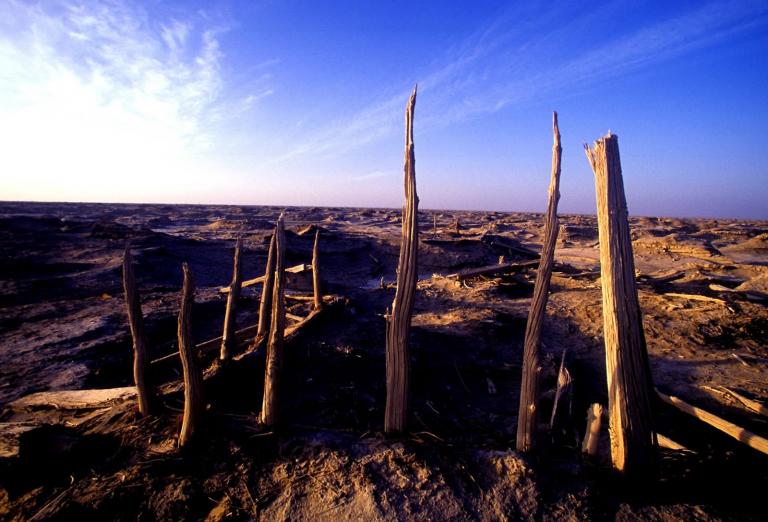The discovery of Ancient City of Loulan
4 min readOn March 28 1900, Sven Hedin, the famous Swedish explorer, led a team to explore Xinjiang and toiled in the desert. Aikedi, the Chinese Uygur guide came across sand storm when he returned to the former path looking for a lost iron axe and accidentally found an ancient castle under the sand. then he told Sven Hedin about the finding. Sven Hedin saw this ancient city have walls, streets and houses and even beacon towers but he had to return because of water shortage

After one year’s preparation, Sven Hedin made a special trip to these ruins on march 3 1901, and did excavation for one week. he excavated from here lots of relicS, including coins, silk fabrics, grains, pottery, 36 pieces of paper with Chinese characters on them, 120 bamboo slips and several brush pens Sven hedin sent the relics to german himmler for appraisal after he went backto his country. Through appraisal, the ancient city was the long lost ancient Loulan which shocked the world
The reappearance of Loulan attracted explorers from all countries to come to look for treasure. British Hungarian Stein, American Huntington and Japanese tachibana zuicho arrived at this “site of ruins of high cultural level in succession and plundered some important relics
People found loulan from under the sand but a bigger riddle was puzzling the explorers-why did loulan prosperous for such a long time disappear without a trace, oasis turning into desert and gobi and the city buried by sand?

In 1878, Russian explorer Przhevalski made an investigation of Lop Nor and found the location of Lop Nor on the Chinese map incorrect, which was not in the southern slope of mount kuruktag but in the slope of alton mountains Lop Nor in which Przhevalski once swam had abundant water and wild birds, but it has turned into desert and saltmarsh nowadays. that is to say, Lop nor was a mobile lake whose actual location was 2 degrees latitude to the south of the mapped location. Przhevalski revealed part of the riddle. In 1979 and 1980, the scientific workers in Xinjlang made several detailed investigation on it and finally the riddle of “Pompei of the Desert”buried in the wind and storm for over 1, 600 years was solved, making people see its true features
Loulan archaeological team of Xinjiang Archaeological Institute found lots of ancient tombs in the lower reaches of peacock river leading to the way of Loulan. Some of the tombs had peculiar and magnificent appearance and what circled the tombs were seven layers of logs from thin to thick and there waswood in radiative shape around them the overall profile was like a small sunmaking people have different mysterious association. What its meaning was is still a riddle to be solved at present.
The correct geographical location of Loulan is 89 degrees 55min, 22s east longitude, and 40 degrees 29min, 55s northern Altitude, with a floor area over 108,000m². the residual wall is about 4m high and 8m wide the wall was built by tamping. The walls of the residential area were built by knitting reed and plastered with clay. There were all wood houses. The column of Euphratica poplar as well as door and window are identifiable. the only earth Architecture was regarded as the residence of the ancient Loulan rulers with wall thickness 1. 1m, 2m of the residual height and facing to the south the earth mound in the east of the city was the Buddha tower worshipped by the citizens
How did Lop Nor move? The scientists believed that, in addition to the fact of the earth’s crust movement, the biggest reason was that lots of sand deposited on the riverbed. The sand of tarim River and peacock River deposited at the mouth of lop nor and finally it blocked the rivercourse And Tarim river and peacock river found other courses and formed new lakes. But the former river was evaporated by the heat and turned into desert. Water is the life of loulan the northern movement of lop nor drained loulan and trees died because of this, so people abandoned the city and fled, leaving onedead city. In the strong sand storms, Loulan was eventually buried in the sand
The disappearance of loulan was also related to people’s destroy of the ecological balance of the nature Loulan was located at the hub of the silk Road, so Han, Xiongnu and other nomadic kingdoms often fought on the soil of loulan people cultivated too much and destroyed water conservant facilities and good vegetation to seek for interests of their own kingdom. “after the 3 century A D, the riverbed in the lower reaches of Tarim River flowing into Lop Nor was blocked by sand, so it changed course to the southeast of the current Yuli to flow to the south”, Loulan”still had city and walls but no people”and”with the passage of time, the kingdom was empty and the city abandoned









